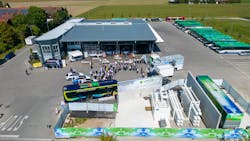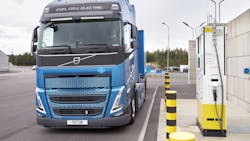Trucking's hydrogen future nears reality overseas
HOFOLDING, Germany—The potential future of clean transportation was on display under the hot Bavarian sun as I joined a dozen other North American trucking and automotive journalists at the grand opening of the region's largest hydrogen commercial vehicle fueling station in this suburb about 15 miles south of Munich.
In a solution developed by Hynergy engineers here, green hydrogen produced at an electrolysis plant about 75 miles away is hauled to the filling station at this municipal bus depot a few times per month. The 1,250-kilogram (2,755-lb.) tanker trailer will be swapped out as the station provides enough daily fuel for at least 25 hydrogen fuel-cell buses and trucks. Fuel-cell buses, the primary early users of the H2 to start, will have about a 215-mile range. And it takes just about 10 minutes to refuel the vehicles.
Building this hydrogen filling station took two years of work by Hy2B Wasserstoff GmbH and lots of funding from the German national and the local Bavarian governments. Because of the government funding, officials told us it will eventually open the filling station to commercial trucks. Hydrogen is taking off here in Germany, where there are 86 filling stations nationwide, according to H2. There are more than 50 H2 refueling stations in California (where all but a handful are private).
See also: NACFE report affirms hydrogen's major role in long-haul trucking's future
The time and millions of euros invested in the Bavarian project needed government support to make this expensive project a reality. But doing this in two years and being able to see actual vehicles benefit from it because of transported green hydrogen can give some hope for the trucking industry in the U.S. While some fleets are finding early success with regional battery-electric trucks, there will not be one solution for the trucking industry as it gets pushed deeper into decarbonization.
Paccar's Kenworth and Peterbilt brands will soon start taking orders for the hydrogen fuel-cell tractor it developed with Toyota Motors. Volvo Trucks and Daimler's joint fuel-cell program, Cellcentric, is finding early development successes in Europe. In Stuttgart, Germany, Bosch is producing fuel-cell stacks for Nikola trucks in the U.S. and hopes to provide the technology to other OEMs. Cummins is also developing a hydrogen internal combustion engine for long-haul trucks as part of its X15 fuel-agnostic engine platform. Volvo Trucks is also producing an ICE for hydrogen in Sweden.
"We are looking into how we can utilize it both in the combustion engine and in the fuel cell," Jessica Sandström, Volvo Trucks head of product management, said during a presentation at the OEM's Gothenburg, Sweden, headquarters less than a week after Germany celebrated another hydrogen fueling station's grand opening (Sweden's first public H2 station is under development in Gothenburg right now). "It's going to be important that it's green hydrogen because hydrogen by itself is not a green fuel. When we talk about how it's used in the truck, it can be a zero-emission—but it's also about the production. To make green hydrogen, you need to have green electricity as the main source."
Hydrogen is exciting because the renewable energy can be harvested all over—particularly in regions filled with sun and wind. It can be sold and hauled as a commodity by truck, such as we saw in Bavaria. But if the electricity needed to extract the H2 from H2O isn't made by solar, wind, or other renewable energy sources, the hydrogen isn't green. It's just shifting the carbon output to another source besides the vehicles.
The creators of fuel cells boast of their efficiency in converting H2 into electricity to power the fuel-cell stacks. While that power conversion is more efficient than traditional internal combustion engines, it still can't work financially without many incentives. And incentives are no way for any business, particularly trucking, to make long-term plans.
Throughout my time in Europe this month exploring alternative-fuel technologies for trucking, the same phrase came up repeatedly when discussing how hydrogen could succeed as a trucking fuel: "It's a chicken or the egg" scenario.
What comes first? The fuel-cell and hydrogen-powered trucks or the H2 fueling infrastructure to support them? Hydrogen proponents believe the infrastructure should be built with H2-powered equipment.
But gas stations didn't come before automobiles. Truck stops didn't come before trucking. BEV charging certainly didn't come before EVs. OEMs and others had to prove that their transportation technology—a Model T over 100 years ago or a VNR Electric more recently—worked before the fueling and power companies saw the commercialization benefits of selling fuel or battery power.
This is why even fleets banking on something besides battery-electric power for decarbonized long-haul operations will likely have to wait before they can see the power of green hydrogen.
However, on a stop days later at Quantron in Augsburg, Germany, we saw a promising future for hydrogen power. The company started as a horse-drawn-carriage taxi service in 1882 and has been developing electric trucks and buses since 2011. It now wants to offer its zero-emissions technology as a service to fleets in the U.S. and Europe. It is combating the chicken-or-the-egg quandary of H2 transport solutions by partnering with FirstElement Fuel in the U.S., where Quantron first displayed its conventional Class 8 FCEV at the Advanced Clean Transportation Expo in Anaheim, California, in May.
It already has several medium-duty box truck FCEVs on its campus. In Germany, a fleet could utilize hydrogen as a power source today and operate across much of the country. But that comes with a lot of political support. While we see more passenger EVs in the U.S., it doesn't compare to how the Europeans have taken to ZE technology.
The development of hydrogen fuel-cell trucks will create a demand for hydrogen refueling stations, and the development of hydrogen refueling infrastructure will make hydrogen fuel-cell trucks more viable. With fueling times comparable to diesel—but without the carbon—it could be worth the wait and the investments.
Our wait in America is getting shorter. But it's harder to imagine H2 stations popping up as quickly nationwide without some early successes on U.S. soil.
California has the most hydrogen fueling stations in the U.S. Fleets there also have the most incentive to test out and adopt this technology. If the hydrogen fuel cells and hydrogen engines can succeed early in the Golden State, it could give hydrogen suppliers an excellent reason to invest in the infrastructure elsewhere in the U.S., which certainly has a lot of sun and wind capable of creating green hydrogen—and many fleets capable of transporting it to fueling stations just like the one the Bavarian government is celebrating this fall.
About the Author
Josh Fisher
Editor-in-Chief
Editor-in-Chief Josh Fisher has been with FleetOwner since 2017. He covers everything from modern fleet management to operational efficiency, artificial intelligence, autonomous trucking, alternative fuels and powertrains, regulations, and emerging transportation technology. Based in Maryland, he writes the Lane Shift Ahead column about the changing North American transportation landscape.





